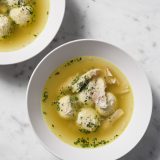The word polpette usually is translated as meatballs, but in Italy, it’s a term that can entail so much more. Deliciously so. “Polpette just means something in the shape of a ball,” says Calabrian-born cookbook author Rosetta Costantino.
And that’s a freedom taken seriously in southern Italy, where polpette are made with everything—artichokes, cauliflower, zucchini, mushrooms, even tuna. “We make more polpette meatless than we do with meat,” she says. Among her favorites? Ricotta polpette.
These surprisingly light cheese-based dumplings have been part of Calabria’s tradition of cucina povera for centuries, making use of ingredients that historically were abundant and cheap, particularly stale bread. The most basic recipes involve mixing little more than breadcrumbs and creamy ricotta cheese with whole eggs and grated pecorino Romano cheese. The mild ricotta provides an ideal foil for the salty, savory, pleasantly sharp pecorino.
Today, these plump, feather-light ricotta polpette find their way into several recipes in Costantino’s kitchen, using homemade ricotta and eggs from her own chickens.
Sometimes she does little more than bread and fry them. Other times, she simmers them in tomato sauce, or rolls them into bite-size morsels that she poaches in chicken broth. That latter option is the basis of polpette di ricotta in brodo, a lovely, light Calabrian dish that falls somewhere between matzo ball soup and chicken and dumplings.
We loved the elegant simplicity of the dish, at once rich and savory, yet still light and simple. For our version, we found that egg yolks were a better binder than the more traditional whole eggs. We also discovered that the dumplings benefited from resting both before and after they were cooked.
A rest before cooking gave the flavors in the ricotta dumplings time to meld. It also allowed the breadcrumbs to more fully hydrate, ensuring that the polpette didn’t fall apart while poaching in the broth.
After the dumplings cooked, we found that a second rest helped them firm up just enough to ensure they would hold their shape without becoming dense or unpleasantly tough.
With polpette di ricotta in brodo, a rich broth is crucial. For our version, we take a simple shortcut, by simmering chicken thighs in purchased broth. Thighs are flavorful and can withstand a longer cooking time, allowing the flavors to deeply infuse. This not only enriches the broth, it also gives us perfectly tender meat to add later.
Southern Italy’s Chicken Soup with Ricotta Dumplings
A lighter twist on chicken and dumplings, this deeply savory soup features tender “meatballs” made with ricotta.
Photos: Connie Miller of CB Creatives; Styling: Christine Tobin








